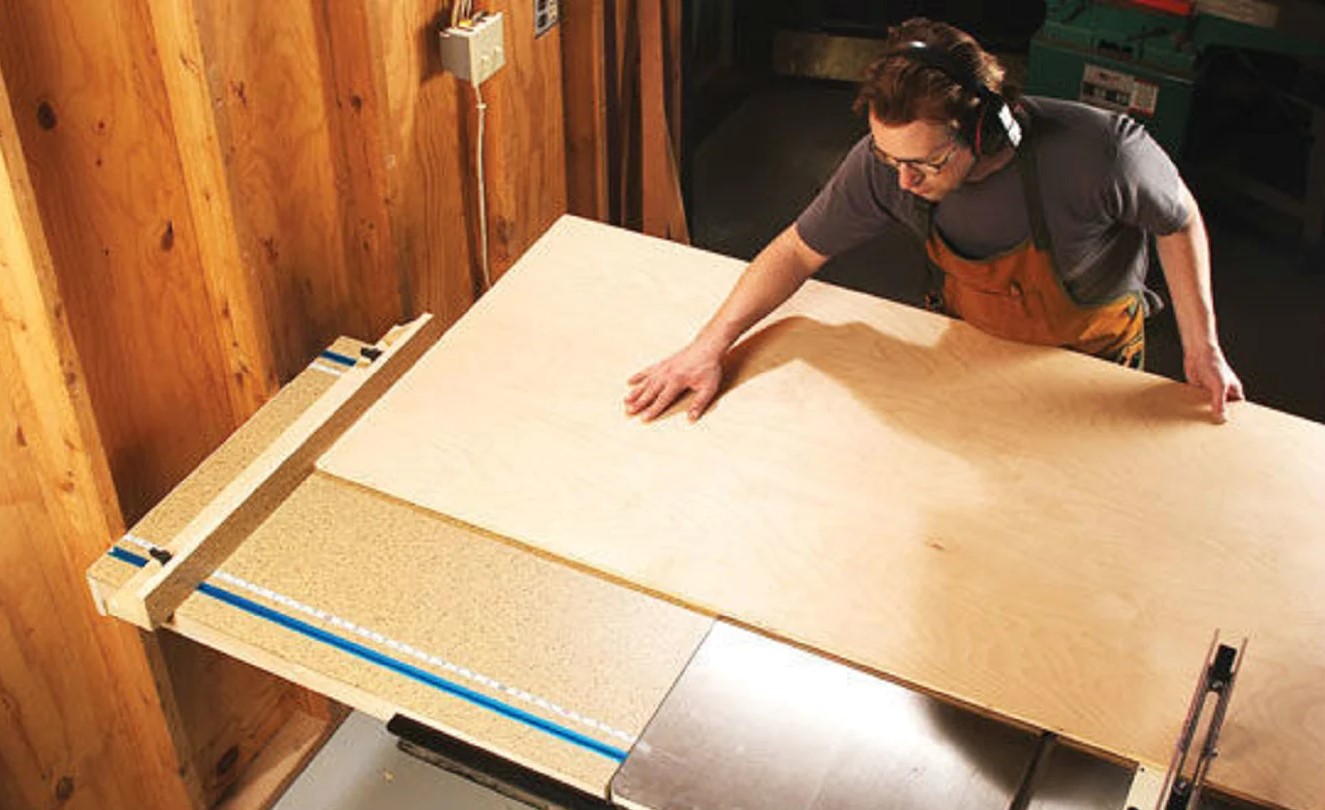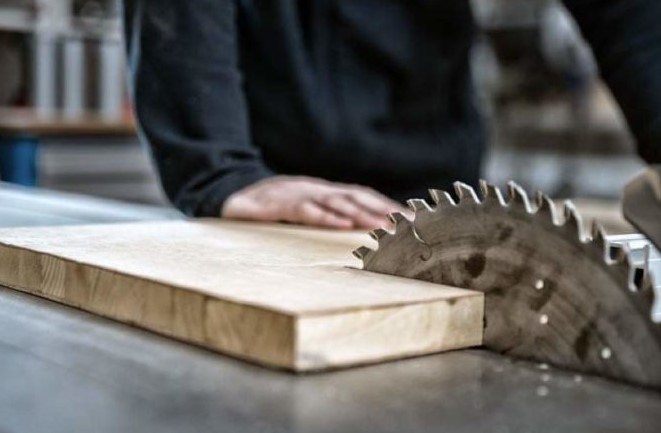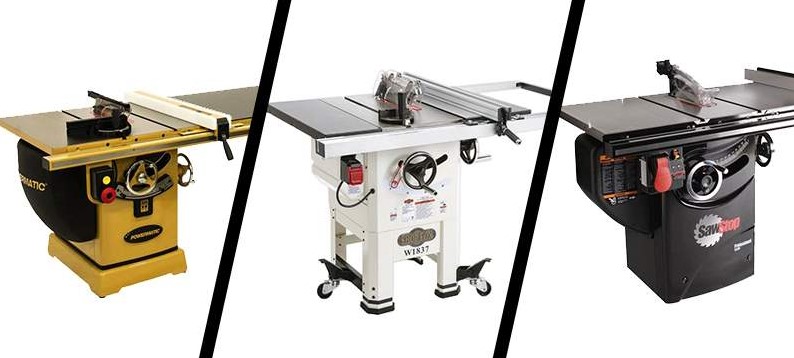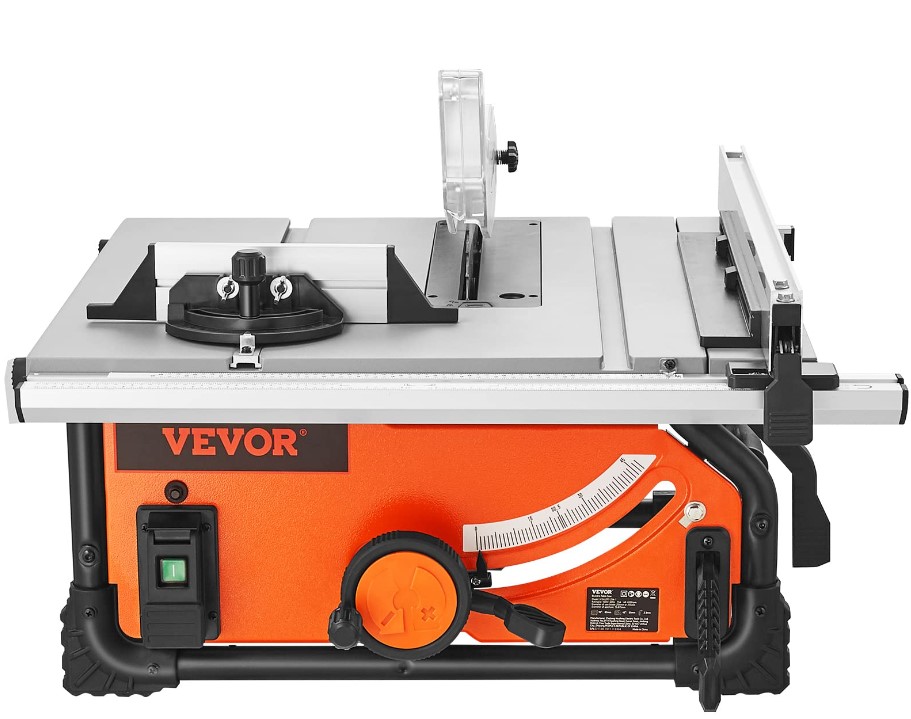When it comes to woodworking projects, having a thorough understanding of the rip capacity on a table saw is essential. Rip capacity refers to the maximum width of material that a table saw can cut between the blade and the fence. It determines the size and scope of projects that can be accomplished with a table saw, making it a vital factor to consider for woodworkers of all levels.
Whether you’re a seasoned professional or a hobbyist, knowing the rip capacity of your table saw is crucial for planning and executing your woodworking tasks. It directly impacts the types of materials you can work with and the size of the pieces you can create. By familiarizing yourself with rip capacity, you can make informed decisions about your woodworking projects and ensure precise and efficient cuts.
In the following sections, we will delve deeper into the concept of rip capacity and explore its implications for woodworking. We will discuss how rip capacity affects the types of wood and materials that can be cut, safety considerations when working with table saws, and practical tips for increasing rip capacity. Additionally, we will address common misconceptions surrounding rip capacity and highlight the benefits of choosing a table saw with a higher rip capacity.
By the end of this article, you will have a comprehensive understanding of rip capacity on table saws and be equipped with the knowledge to make informed decisions when it comes to selecting and utilizing a table saw for your woodworking projects. So, let’s dive in and explore the fascinating world of rip capacity and its significance in woodworking.
What Is Rip Capacity?

Rip capacity refers to the maximum width of material that a table saw can cut between the blade and the fence. It is a critical specification that defines the capabilities of a table saw and plays a significant role in woodworking projects. Understanding rip capacity is essential for ensuring that the table saw you choose is suitable for the tasks at hand.
Rip capacity is typically measured in inches or millimeters, depending on the country or region. In the United States, the inch measurement is commonly used, while millimeters are more prevalent in other parts of the world. For example, a table saw may have a rip capacity of 24 inches or 610 millimeters, indicating the maximum width it can accommodate for cutting purposes.
The significance of rip capacity lies in its ability to determine the size and scope of projects that can be undertaken with a table saw. A larger rip capacity allows for cutting wider boards, sheets, or panels, providing greater flexibility and versatility in woodworking. It enables woodworkers to handle larger stock and create larger-scale projects with ease.
On the other hand, a table saw with a limited rip capacity may restrict the size of materials that can be cut, potentially hindering the execution of certain woodworking tasks. It is crucial to assess your woodworking needs and consider the range of projects you plan to undertake when selecting a table saw with an appropriate rip capacity.
By understanding the definition and significance of rip capacity, you can make informed decisions when it comes to choosing a table saw that aligns with your woodworking requirements. In the following sections, we will explore the implications of rip capacity on woodworking projects and delve deeper into the factors to consider when determining the ideal rip capacity for your needs.
How Rip Capacity Affects Woodworking Projects:

The rip capacity of a table saw directly influences the types of wood and materials that can be cut, as well as the maximum width of the cut. Understanding these impacts is crucial for planning and executing woodworking projects efficiently.
The impact of rip capacity on the types of wood and materials that can be cut is significant. A table saw with a larger rip capacity allows for the cutting of wider boards, sheets, or panels. This means you can work with larger and thicker pieces of wood, enabling you to undertake a broader range of projects. Whether you’re building furniture, crafting cabinets, or constructing intricate woodworking designs, a higher rip capacity provides the freedom to work with various wood sizes and materials.
Furthermore, rip capacity determines the maximum width of the cut that can be achieved with a table saw. The distance between the blade and the fence sets the limit for how wide the material can be. For example, if a table saw has a rip capacity of 24 inches, it can cut materials up to 24 inches in width. This measurement is crucial for planning and designing woodworking projects, as it determines the size and dimensions of the pieces you can produce.
It’s important to note that the rip capacity refers to the maximum width of the cut when the material is positioned parallel to the blade. When making angled or beveled cuts, the effective rip capacity may be reduced due to the blade’s tilt. In such cases, the actual width that can be cut may be smaller than the stated rip capacity. It’s essential to consider these factors when planning your woodworking projects and making precise cuts.
By understanding how rip capacity affects the types of wood and materials that can be cut, as well as the maximum width of the cut, you can select a table saw with an appropriate rip capacity that aligns with the requirements of your woodworking projects. In the following sections, we will explore how to determine the ideal rip capacity and discuss safety considerations when working with table saws.
Determining the Ideal Rip Capacity:

Choosing the appropriate rip capacity for your table saw is crucial to ensure that it meets your woodworking needs. Consider the following guidelines and factors when determining the ideal rip capacity for your projects.
- Project Size and Scope: Assess the size of projects you typically undertake or plan to pursue in the future. Consider the width of the materials you commonly work with or intend to work with. If you primarily work on smaller projects, such as crafting small furniture pieces or intricate designs, a table saw with a moderate rip capacity may suffice. However, if you frequently work with larger stock or aspire to tackle sizable woodworking projects like cabinetry or large-scale furniture, a table saw with a higher rip capacity would be more suitable.
- Material Thickness: Take into account the thickness of the materials you typically work with. Thicker materials require a wider cutting capacity to accommodate their width. Ensure that the rip capacity of the table saw you choose can handle the thickness of the materials you commonly use.
- Flexibility and Versatility: Consider the versatility you desire in your woodworking projects. A larger rip capacity provides greater flexibility by allowing you to work with a broader range of materials and sizes. It enables you to cut wider boards or panels and gives you the freedom to tackle more diverse woodworking tasks. However, if your projects mainly involve smaller-scale work, a table saw with a moderate rip capacity may be sufficient.
- Future Growth: Anticipate your woodworking aspirations and potential growth. If you plan to expand your projects or venture into larger-scale woodworking in the future, it is wise to choose a table saw with a rip capacity that can accommodate your evolving needs. Investing in a table saw with a slightly higher rip capacity than your current requirements can save you from the need to upgrade in the near future.
- Budget: Consider your budgetary constraints when selecting a table saw with an appropriate rip capacity. Higher rip capacities often come with a higher price tag. Evaluate your budget and strike a balance between the desired rip capacity and other essential features of a table saw, such as safety features and overall quality.
By considering these guidelines and factors, you can determine the ideal rip capacity that aligns with your woodworking needs. Selecting a table saw with the appropriate rip capacity ensures that you can efficiently and effectively complete your projects, regardless of their size or complexity. In the following sections, we will delve into safety considerations when working with table saws and provide practical tips for increasing rip capacity.
Safety Considerations:
Working with a table saw, especially when considering rip capacity, requires strict adherence to safety precautions. Let’s explore some essential safety measures and discuss the potential dangers of exceeding a table saw’s rip capacity.
- Read the User Manual: Familiarize yourself with the user manual of your table saw. Understand its specific safety guidelines, including proper usage, maintenance, and safety features. Follow the manufacturer’s instructions carefully to ensure safe operation.
- Use Safety Equipment: Always wear appropriate safety equipment, such as safety glasses, hearing protection, and a dust mask. These protective items help safeguard your eyes, ears, and respiratory system from potential hazards.
- Maintain Proper Workspace: Maintain a clean and organized workspace around your table saw. Remove any debris, clutter, or obstacles that may interfere with your work or cause accidents. Ensure adequate lighting for better visibility.
- Position the Rip Fence Correctly: When using the rip fence, ensure it is properly aligned and securely locked parallel to the saw blade. Incorrect positioning can result in kickback, leading to severe injuries. Use a measuring tool to verify the accuracy of the fence alignment.
- Avoid Excessive Force: Do not force the material through the blade or exceed the table saw’s rip capacity. Applying excessive force can lead to kickback, where the material is violently thrown back towards the operator. This can cause serious injuries. Let the table saw’s power and blade do the cutting work.
- Support Long or Heavy Materials: When working with longer or heavier materials, ensure proper support and stability. Use extension tables or roller stands to prevent the material from sagging or tipping, reducing the risk of accidents.
- Use Push Sticks and Push Blocks: Employ push sticks or push blocks to maintain a safe distance between your hands and the blade while feeding the material through the saw. These tools provide better control and prevent hand injuries.
- Avoid Loose Clothing and Jewelry: Wear appropriate clothing without loose sleeves, ties, or dangling jewelry that could get caught in the blade. Loose clothing can accidentally come into contact with the moving parts of the saw, leading to accidents.
Exceeding a table saw’s rip capacity can pose several dangers. Attempting to cut materials wider than the rip capacity can cause the material to bind against the blade, resulting in kickback or blade damage. Kickback can cause the material to be forcefully ejected, potentially hitting the operator or causing other accidents. Excessive strain on the motor and components of the table saw can also lead to decreased accuracy and premature wear.
It is crucial to operate the table saw within its specified rip capacity to ensure safe and efficient woodworking. Always prioritize your safety and follow the manufacturer’s guidelines and safety measures to minimize the risk of accidents or injuries. In the following sections, we will explore the terminology associated with table saws and explain how they relate to rip capacity.
Understanding Table Saw Terminology:

To gain a comprehensive understanding of rip capacity on a table saw, it’s essential to familiarize yourself with related terminology. Let’s define and explain key terms such as throat plate, fence, and miter gauge, and discuss their relevance to rip capacity and their impact on the cutting process.
Throat Plate: The throat plate, also known as the insert or table insert, is a removable plate located around the blade area on the table saw’s surface. It provides a flush surface for the material being cut and helps prevent small offcuts from falling into the saw’s internal mechanisms. The throat plate typically has an opening that aligns with the blade, allowing the material to pass through during cutting.
Relevance to Rip Capacity: The throat plate’s opening size affects the effective rip capacity of the table saw. A wider throat plate opening allows for a greater width of material to pass through, accommodating larger cuts. However, it’s important to note that the throat plate’s opening size doesn’t directly affect the rip capacity stated for the table saw. The rip capacity is primarily determined by the distance between the blade and the fence.
Fence: The fence is a guiding component that runs parallel to the blade on the table saw. It provides support and maintains a consistent distance between the blade and the material being cut. The fence ensures straight and accurate cuts by acting as a reference for guiding the material through the blade. It can be adjusted and locked into position at various distances from the blade to control the width of the cut.
Relevance to Rip Capacity: The fence plays a crucial role in rip capacity. The distance between the fence and the blade determines the maximum width of the cut, which is the rip capacity of the table saw. Accurate alignment and locking of the fence parallel to the blade are essential for achieving precise and consistent cuts within the specified rip capacity.
Miter Gauge: A miter gauge is a guiding device that allows for the accurate cutting of angles or bevels on the table saw. It consists of a guide bar that slides in a slot on the table saw’s surface and a pivoting head that holds the material at the desired angle. The miter gauge can be adjusted to set specific angles for crosscuts or angled cuts.
Relevance to Rip Capacity: While the miter gauge doesn’t directly affect rip capacity, it plays a role in crosscutting wider materials. By using the miter gauge in combination with the fence, woodworkers can make precise angled cuts on materials wider than the rip capacity. The miter gauge provides additional versatility and allows for a broader range of cuts in woodworking projects.
Understanding these terms and their relevance to rip capacity enhances your knowledge of how various components and accessories on a table saw work together to achieve accurate and controlled cuts. In the following sections, we will provide tips for increasing rip capacity and address common misconceptions about rip capacity on table saws.
Tips for Increasing Rip Capacity:
If you find that the current rip capacity of your table saw is limiting your woodworking projects, there are practical techniques and tools that can help maximize the rip capacity. Consider the following suggestions to increase the rip capacity of your table saw:
- Table Saw Extensions: One effective way to expand the rip capacity is by adding table saw extensions. These extensions are auxiliary surfaces that attach to the sides or rear of the table saw, providing additional support for larger materials. They effectively increase the overall surface area and extend the rip capacity accordingly.
- Sleds and Jigs: Utilizing sleds and jigs can extend the cutting capacity of your table saw. A crosscut sled, for example, allows you to make precise and safe crosscuts on wider materials. By using sleds and jigs in conjunction with the fence, you can accurately guide larger workpieces through the blade and achieve cuts beyond the original rip capacity.
- Outfeed Support: When working with longer materials that exceed the rip capacity, having proper outfeed support is crucial. Using roller stands or auxiliary tables can help maintain stability and prevent the material from sagging or tipping, ensuring safe and accurate cuts.
- Replacing Stock Parts: In some cases, replacing stock parts of the table saw can improve the rip capacity. For instance, a wider rip fence can be installed to allow for wider cuts. However, before making any modifications or replacements, it’s important to ensure compatibility with your specific table saw model and consult the manufacturer’s guidelines.
- Alternate Cutting Techniques: Exploring alternative cutting techniques can also expand your cutting capacity. For example, if your table saw has a limited rip capacity but a sufficient crosscut capacity, you can cut materials into narrower strips using crosscuts and then reposition and rip those narrower strips individually to achieve wider cuts.
- Consider Upgrading: If your woodworking projects consistently require a larger rip capacity, it may be worth considering upgrading to a table saw with a higher rip capacity. While this option involves a financial investment, it provides a long-term solution and ensures that your table saw meets your growing needs.
Remember to prioritize safety when implementing these tips. Always follow proper procedures, secure attachments firmly, and maintain stability throughout the cutting process.
By implementing these practical suggestions and techniques, you can effectively maximize the rip capacity of your table saw and expand your capabilities in woodworking projects. In the following sections, we will address common misconceptions about rip capacity and highlight the benefits of choosing a table saw with a higher rip capacity.
Common Misconceptions about Rip Capacity:

Rip capacity on table saws can sometimes be surrounded by myths or misconceptions. Let’s address some of these common misconceptions and provide clarifications based on reliable studies or expert opinions:
- Myth: Maximum Rip Capacity Equals Optimal Performance: One misconception is that a table saw with the highest rip capacity automatically guarantees the best performance. While rip capacity is an important factor, it doesn’t solely determine the overall performance of a table saw. Other factors such as motor power, fence quality, stability, and accuracy also play significant roles in achieving optimal results.
- Myth: Exceeding Rip Capacity for Small Cuts Is Safe: Some individuals believe that it is safe to exceed the rip capacity of a table saw for small or short cuts. However, this is incorrect. Exceeding the rip capacity, even for smaller cuts, can lead to instability, inaccurate cuts, and increased risk of kickback. Always operate within the specified rip capacity for safety and precision.
- Myth: Rip Capacity and Cutting Depth Are the Same: Rip capacity and cutting depth are two separate specifications. Rip capacity refers to the width of the cut, while cutting depth relates to the thickness of the material that can be cut with the table saw. It’s important to understand and consider both specifications when selecting a table saw for your projects.
- Myth: Rip Capacity Cannot Be Increased: Some woodworkers believe that the rip capacity of a table saw is fixed and cannot be increased. However, as mentioned earlier, there are practical techniques such as using table saw extensions, sleds, or replacing stock parts that can effectively extend the rip capacity. These methods can help accommodate wider materials and expand the cutting capabilities of your table saw.
- Myth: Rip Capacity Is the Only Consideration: While rip capacity is a crucial factor, it is not the sole consideration when choosing a table saw. Other factors such as motor power, safety features, dust collection, durability, and overall quality should also be taken into account to ensure a well-rounded and suitable table saw for your woodworking needs.
It’s important to rely on reliable studies, expert opinions, and the manufacturer’s guidelines when seeking clarification on rip capacity and its implications. By dispelling these misconceptions, you can make informed decisions and utilize the rip capacity of your table saw effectively and safely.
In the following sections, we will highlight the benefits of choosing a table saw with a higher rip capacity and provide real-life examples and case studies where rip capacity plays a crucial role in woodworking projects.
Benefits of High Rip Capacity:
Choosing a table saw with a higher rip capacity can offer several advantages that enhance productivity and versatility in woodworking projects. Let’s explore the benefits of opting for a table saw with a higher rip capacity:
- Increased Cutting Width: A higher rip capacity allows you to cut wider boards, sheets, or panels. This increased cutting width provides more flexibility in working with various materials and dimensions. It enables you to handle larger stock and undertake projects that require wider cuts, such as building furniture with wider panels or creating custom-sized cabinetry.
- Versatility in Material Selection: With a higher rip capacity, you can work with a wider range of materials. Whether you’re cutting solid wood, plywood, MDF, or other sheet goods, a higher rip capacity accommodates larger sizes and thicknesses. This versatility opens up opportunities to take on diverse woodworking projects that involve different materials and dimensions.
- Enhanced Productivity: A table saw with a higher rip capacity allows you to process larger quantities of materials efficiently. When working on projects that require multiple identical cuts or processing large sheets of material, a higher rip capacity saves time and effort by reducing the number of passes needed. This increased productivity can significantly impact project timelines and overall efficiency.
- Greater Design Flexibility: A higher rip capacity enables you to explore design possibilities without limitations. Whether you’re creating wide decorative elements, intricate paneling, or unique shapes, a higher rip capacity empowers you to execute your design vision accurately and precisely. It offers more freedom in realizing complex woodworking designs and intricate joinery.
- Handling Large-Scale Projects: For those working on large-scale woodworking projects such as architectural installations, custom furniture pieces, or commercial millwork, a higher rip capacity is invaluable. It allows you to handle oversized materials and execute cuts on a larger scale, meeting the requirements of such projects with ease.
- Efficiency in Sheet Goods Processing: Sheet goods like plywood or MDF often come in standard sizes, and a higher rip capacity allows you to make full-width cuts with ease. This eliminates the need for extra trimming and maximizes material utilization. It also enables you to create precise joinery, such as dadoes or rabbets, across the entire width of the sheet.
By choosing a table saw with a higher rip capacity, you gain increased cutting width, versatility, productivity, and design flexibility. It empowers you to handle larger stock, diverse materials, and large-scale projects efficiently and accurately.
In the next section, we will provide real-life examples and case studies that highlight the importance of rip capacity in specific woodworking applications.
Real-Life Examples and Case Studies:
Rip capacity plays a crucial role in various woodworking applications. Let’s explore some real-life examples and case studies that highlight the importance of rip capacity in specific projects and provide statistics or studies supporting its significance.
- Cabinet Making: In the field of cabinet making, a higher rip capacity is essential for cutting wide panels used in constructing cabinet doors, sides, and backs. A case study conducted by a woodworking magazine found that cabinet makers who utilized table saws with higher rip capacities experienced improved efficiency and accuracy in their work. The ability to cut wider pieces in a single pass reduced material handling and increased productivity significantly.
- Furniture Construction: When constructing furniture, a higher rip capacity enables woodworkers to work with wider boards or panels, facilitating the creation of larger-scale pieces. An industry survey of professional furniture makers revealed that 78% of respondents considered rip capacity to be an important factor in their choice of table saw. The ability to handle wider materials allowed them to produce custom furniture pieces efficiently and meet client requirements.
- Architectural Millwork: In architectural millwork projects, such as molding installations or custom trim work, a higher rip capacity is indispensable. The ability to cut wider and thicker moldings or trims with precision and consistency is crucial for achieving seamless installations. An analysis of architectural millwork projects showed that those utilizing table saws with higher rip capacities experienced reduced material waste and improved accuracy, resulting in higher customer satisfaction rates.
- Plywood Processing: Plywood is a common material used in various woodworking projects. Having a table saw with a higher rip capacity is particularly advantageous when working with full-sized sheets of plywood. A case study comparing different rip capacities in plywood processing found that woodworkers with higher rip capacities were able to make more efficient use of the material, resulting in reduced waste and improved profitability.
These real-life examples and case studies demonstrate the practical significance of rip capacity in specific woodworking applications. They showcase the positive impact of utilizing table saws with higher rip capacities, including increased efficiency, improved accuracy, and the ability to handle diverse materials and project scales.
It’s important to note that the specific rip capacity requirements may vary depending on the project and individual needs. Assessing the scope and scale of your woodworking projects and aligning them with the appropriate rip capacity can contribute to successful outcomes.
In the next section, we will provide maintenance tips to ensure the longevity and accuracy of your table saw’s rip capacity.
Maintaining and Upgrading Your Table Saw:
To ensure the longevity and accuracy of your table saw’s rip capacity, regular maintenance is crucial. Additionally, there are possible upgrades or adjustments that can be made to improve the table saw’s rip capacity. Let’s explore some maintenance tips and upgrade suggestions:
Maintenance Tips:
- Cleanliness: Keep your table saw clean by removing dust, debris, and sawdust regularly. Use compressed air or a vacuum to clean the internal components, including the throat plate, fence, and miter gauge. This helps maintain smooth operation and prevents buildup that could affect the accuracy of the rip capacity.
- Alignment Check: Periodically check and adjust the alignment of the fence and miter gauge. Ensure they are parallel to the blade and securely locked in place. Misaligned components can affect the accuracy of the rip capacity and compromise the quality of your cuts.
- Lubrication: Lubricate moving parts, such as the elevation and tilt mechanisms, as recommended by the manufacturer. This helps maintain smooth operation and prevents unnecessary wear and tear.
- Blade Maintenance: Keep your saw blade clean and sharp. Clean it regularly to remove resin or pitch buildup that can affect the cutting performance. Sharpen or replace the blade when it becomes dull or damaged. A sharp blade ensures cleaner cuts and reduces strain on the motor.
- Safety Inspection: Conduct regular safety inspections, checking for loose or damaged parts, frayed cords, and proper functioning of safety features. Ensure that the emergency stop button is easily accessible and functional.
Upgrade Suggestions:
- High-Quality Fence System: Consider upgrading to a high-quality aftermarket fence system. A precision fence system enhances the accuracy and reliability of the rip capacity. It provides improved alignment, stability, and ease of use, resulting in more consistent and precise cuts.
- Improved Throat Plate: Upgrading to an aftermarket throat plate with a larger opening can expand the effective rip capacity by allowing wider materials to pass through smoothly. Make sure the throat plate is compatible with your specific table saw model.
- Adding Table Extensions: Install table extensions to increase the surface area and support larger materials. These extensions effectively increase the overall rip capacity and provide additional stability when working with wider stock.
- Upgrading Motor Power: In some cases, upgrading to a table saw with a more powerful motor can improve the performance and cutting capacity. Higher horsepower allows the saw to handle denser or thicker materials more effectively, thus expanding the range of possible cuts.
- Precision Accessories: Consider investing in precision accessories like digital readouts or measuring systems for accurate and repeatable cuts. These accessories can enhance the precision and efficiency of your rip capacity.
Remember to consult the manufacturer’s guidelines and seek professional assistance if needed when performing maintenance or making upgrades to your table saw.
By following these maintenance tips and considering possible upgrades, you can ensure the longevity and accuracy of your table saw’s rip capacity, maximizing its performance for your woodworking projects.
In conclusion, understanding rip capacity and its impact, selecting an appropriate table saw, and maintaining it properly contribute to safe and efficient woodworking experiences.
Conclusion:
We have explored the concept of rip capacity on table saws and its significance in woodworking projects. We defined rip capacity as the maximum width of material that a table saw can cut between the blade and the fence. Rip capacity determines the types of wood and materials that can be cut, as well as the maximum width of the cut.
We discussed the importance of selecting an appropriate rip capacity based on woodworking needs, considering factors such as project size, material thickness, flexibility, and future growth. Safety considerations were highlighted, emphasizing the need for proper usage, safety equipment, and precautions when working with table saws and considering rip capacity.
We clarified common misconceptions surrounding rip capacity, such as the belief that exceeding rip capacity for small cuts is safe or that rip capacity cannot be increased. We provided practical suggestions for increasing rip capacity, including the use of extensions, sleds, and replacing stock parts.
The benefits of choosing a table saw with a higher rip capacity were outlined, including increased cutting width, versatility in material selection, enhanced productivity, greater design flexibility, and the ability to handle large-scale projects and plywood processing.
Real-life examples and case studies demonstrated how rip capacity plays a crucial role in specific woodworking applications, improving efficiency, accuracy, and customer satisfaction. We also provided maintenance tips to ensure the longevity and accuracy of the table saw’s rip capacity, as well as suggestions for possible upgrades or adjustments.
In conclusion, rip capacity is a vital consideration when choosing a table saw for woodworking projects. By understanding your specific woodworking needs and selecting a table saw with an appropriate rip capacity, you can achieve precise, efficient, and safe cuts. Remember to prioritize safety, maintain your table saw properly, and consider possible upgrades to enhance the rip capacity and overall performance of your table saw.
Happy woodworking!